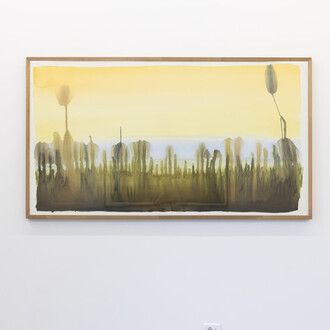The work of Arturo Berned emerges from a dialogue between architecture and sculpture, between logic and intuition, between system and emotion. Rooted in a deep understanding of structure and proportion, Berned's practice reflects a lifelong inquiry into the expressive potential of geometry. In In search of the lines, the artist presents a compelling synthesis of form, material, and philosophy-an oeuvre that challenges the boundaries between disciplines while embracing the timeless language of abstraction.
Trained as an architect, Berned approaches sculpture not merely as a matter of aesthetic arrangement, but as a spatial problem to be solved-one in which harmony is achieved through precision, and beauty emerges through constraint. His preferred materials-steel in its stainless, lacquered, or corten varieties-convey a powerful sense of permanence, industrial strength, and elemental simplicity. But Berned softens this weight through rhythm and proportion, employing the golden section as a generative principle to guide his constructions. Each sculpture becomes a meditation on balance: between heaviness and lightness, between presence and void, between the finite and the infinite.
Though the materials and mathematics suggest a cool rationality, Berned's sculptures are deeply poetic. They reflect not only an intellect honed in the discipline of architecture, but a sensibility attuned to movement, light, and human perception. Whether installed in urban plazas or white-cube galleries, his works invite viewers into a kinetic relationship-drawing them into space and offering new perspectives as they move around the piece. It is in this shifting encounter that Berned's art truly unfolds: not as static objecthood, but as lived, spatial experience.
Berned's transition from architecture to art was marked by pivotal moments of recognition. In the early 2000s, he received Spain's National Architecture Prize for his collaboration on the Infanta Leonor Hospital in Madrid, and won the Loewe International Sculpture Competition. Yet it was shortly after these honors that he decided to redirect his focus to sculpture-a decision that led to his first solo exhibition in 2008 in Madrid, and later to a major retrospective at the IVAM (Institut Valencià d'Art Modern) in 2012, where fifty of his works were presented as a unified, coherent vision.
His international trajectory has been equally significant. In 2013, Berned became the first Spanish artist to participate in Lady Dior as seen by, interpreting the iconic Dior handbag through sculptural form. That same year, his engagement with Japanese culture resulted in a major public art initiative sponsored by Toyo Ito for the Spain-Japan Dual Year. The resulting series, imbued with Zen-inspired simplicity and openness, marked the culmination of a phase he named Mu-a term suggesting emptiness as generative potential, and a blank slate from which all creation begins.
As a sculptor, Berned stands in continuity with a lineage of architect-artists-figures such as Le Corbusier, Zaha Hadid, and Santiago Calatrava-who have translated the language of construction into a medium of aesthetic contemplation. Yet unlike many of his contemporaries, Berned maintains an unwavering commitment to abstraction, trusting in the enduring power of pure form to evoke meaning beyond the figurative.
In search of the lines is both a title and a statement of purpose. It alludes to the artist's continuous quest for order and expression through the line-a primary gesture that organizes space and gives rise to structure. In Berned's hands, the line becomes volume, tension, direction, and harmony. It becomes architecture distilled into sculpture. Geometry made lyrical.













